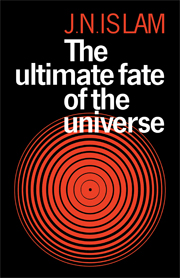Book contents
- Frontmatter
- Contents
- Preface
- Dedication
- Note on some conventions
- 1 Introduction
- 2 Our Galaxy
- 3 The large-scale structure of the universe
- 4 Elementary particles – a preliminary look
- 5 Is the universe open or closed?
- 6 Three ways for a star to die
- 7 Black holes and quasars
- 8 Galactic and supergalactic black holes
- 9 A black hole is not forever
- 10 Slow and subtle changes
- 11 Future of life and civilization
- 12 A collapsing universe
- 13 The steady state theory
- 14 The stability of the proton
- 15 Epilogue
- Glossary
- Selected bibliography
- Index
13 - The steady state theory
Published online by Cambridge University Press: 06 July 2010
- Frontmatter
- Contents
- Preface
- Dedication
- Note on some conventions
- 1 Introduction
- 2 Our Galaxy
- 3 The large-scale structure of the universe
- 4 Elementary particles – a preliminary look
- 5 Is the universe open or closed?
- 6 Three ways for a star to die
- 7 Black holes and quasars
- 8 Galactic and supergalactic black holes
- 9 A black hole is not forever
- 10 Slow and subtle changes
- 11 Future of life and civilization
- 12 A collapsing universe
- 13 The steady state theory
- 14 The stability of the proton
- 15 Epilogue
- Glossary
- Selected bibliography
- Index
Summary
One of the most interesting of the non-standard models of the universe is the steady state theory, which has been the source of much controversy in the past. This controversy has, I believe, been healthy for the subject of cosmology, resulting in the creation of a great deal of interest in the subject and also stimulating new research which has led to important advances in astrophysics and cosmology. The steady state theory is currently not in favour for reasons which will be explained below.
The steady state theory was put forward by H. Bondi and T. Gold and independently by F. Hoyle in the same year (1948). The approach of Bondi and Gold was different from that of Hoyle, although the end result was the same. Bondi and Gold modified one of the cosmological assumptions to arrive at their theory, whereas Hoyle modified Einstein's equations.
In Chapter 3 I mentioned the Cosmological Principle, according to which the universe appears to be homogeneous and isotropic everywhere at any given time. The Principle of course allows the universe to evolve in time; in other words the universe can appear to be different at different epochs in its history. Bondi and Gold extended this principle to what is called the Perfect Cosmological Principle, according to which the universe is not only homogeneous and isotropic everywhere at any given time, but it appears on the average, to be the same at any time.
- Type
- Chapter
- Information
- The Ultimate Fate of the Universe , pp. 115 - 117Publisher: Cambridge University PressPrint publication year: 1983



